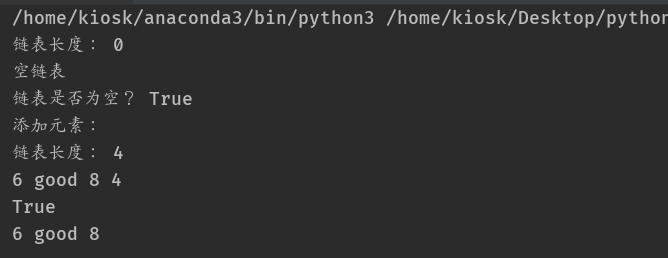Linked list is a common basic data structure. It is a kind of linear table, but it does not store data continuously like the sequential table, but stores the location information (i.e. address) of the next node in each node (data storage unit).
So what is a single chain table?
A one-way linked list is also called a single linked list. Each node contains two domains, an information domain (element domain) and a link domain. The link points to the next node in the list, and the link field of the last node points to a null value.
Table element field elem is used to store specific data.
The location where the next link domain is used to store the next node (the identity in python)
The variable p points to the location of the head node (the head node) of the linked list. Starting from P, any node in the list can be found.
The following package a single chain table, so that it has the most basic functions.
The specific implementation code and effect are as follows:
"""
Date: 2019--06 16:11
User: yz
Email: 1147570523@qq.com
Desc:
"""
class Node(object):
def __init__(self, element):
self.element = element
self.next = None
class SingleLink(object):
def __init__(self):
self.head = None
def is_empty(self):
return self.head == None
def __len__(self):
if self.is_empty():
return 0
else:
cur = self.head
length = 0
while cur != None:
length += 1
cur = cur.next
return length
def trvel(self):
if not self.is_empty():
cur = self.head
while cur.next != None:
print(cur.element, end=' ')
cur = cur.next
print(cur.element)
else:
print("Empty linked list")
def append(self, item):
node = Node(item)
if self.is_empty():
self.head = node
else:
cur = self.head
while cur.next != None:
cur = cur.next
cur.next = node
def add(self, item):
node = Node(item)
node.next = self.head
self.head = node
def insert(self, index, item):
if index <= 0:
self.add(item)
elif index >= len(self):
self.append(item)
else:
node = Node(item)
count = 0
cur = self.head
while count < index - 1:
count += 1
cur = cur.next
node.next = cur.next
cur.next = node
def remove(self, item):
cur = self.head
pre = None
while cur != None:
# Specified element found
if cur.element == item:
# If the first one is the deleted node
if not pre:
# Point the head pointer to the next node of the head node
self.head = cur.next
else:
# Point the next of the previous node of the delete location to the next node of the delete location
pre.next = cur.next
break
else:
pre = cur
cur = cur.next
def search(self, item):
"""Whether the link list lookup node exists and returns True perhaps False"""
cur = self.head
while cur != None:
if cur.element == item:
return True
cur = cur.next
return False
if __name__ == '__main__':
link = SingleLink()
print("Chain length:", len(link))
link.trvel()
print("Is the list empty?", link.is_empty())
print("Add element:")
link.append(8)
link.append(4)
#Link list header add
link.add(6)
#Link list specified location add
link.insert(1, 'good')
print("Chain length:", len(link))
# Calendar list
link.trvel()
#Delete 4
link.remove(4)
#Find whether the element 6 exists in the linked list
print(link.search(6))
link.trvel()

In this way, our single chain table is packaged. It also has the basic function of single chain table.